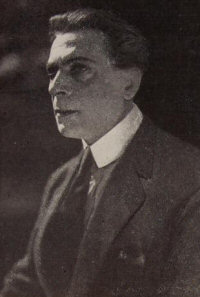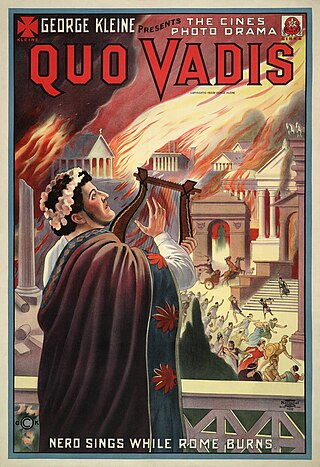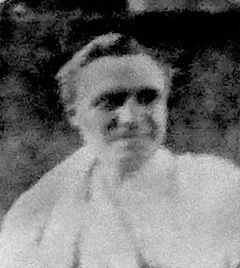
Cleopatra is a 1917 American silent historical drama film based on H. Rider Haggard's 1889 novel Cleopatra, the 1890 play Cleopatre by Émile Moreau and Victorien Sardou, and the play Antony and Cleopatra by William Shakespeare. The film starred Theda Bara in the title role, Fritz Leiber Sr. as Julius Caesar, and Thurston Hall as Mark Antony.
Antony and Cleopatra is a play by William Shakespeare.

Giuseppa Iolanda Menichelli, known professionally as Pina Menichelli, was an Italian actress. After a career in theatre and a series of small film roles, Menichelli was launched as a film star when Giovanni Pastrone gave her the lead role in The Fire (1916). Over the next nine years, Menichelli made a series of films, often trading on her image as a diva and on her passionate, decadent eroticism. Menichelli became a global star, and one of the most appreciated actresses in Italian cinema, before her retirement in 1924, aged 34.
The Wedding March is a 1915 silent Italian drama film directed by Carmine Gallone.

Malombra is a 1917 silent Italian drama film directed by Carmine Gallone. The film was shown as part of the Silent Divas of the Italian Cinema programme at the 38th New York Film Festival in 2000. It is an adaptation of the 1881 novel Malombra by Antonio Fogazzaro, which was later adapted into a 1942 film of the same name.

Amleto Novelli was an Italian film actor of the silent era. He appeared in 110 films between 1909 and 1924.

Fabiola is a 1918 Italian silent historical film directed by Enrico Guazzoni and starring Augusto Mastripietri, Amleto Novelli and Elena Sangro. It is an adaptation of the 1854 novel Fabiola by Nicholas Patrick Wiseman about the rise of Christianity in the Roman Empire. It was one of a series of historical epics for which the Italian film industry became famous during the era. The novel was later turned into a sound film of the same name in 1949.

Quo Vadis is an Italian film directed by Enrico Guazzoni for Cines in 1913, based on the 1896 novel of the same name written by Henryk Sienkiewicz. It was one of the first blockbusters in the history of cinema, with 5,000 extras, lavish sets, and a lengthy running time of two hours, setting the standard for "superspectacles" for decades to come.

Agrippina is a 1911 Italian silent historical film directed by Enrico Guazzoni and starring Adele Bianchi Azzarili, Amleto Novelli and Maria Caserini. The film portrays the life of Agrippina the Younger, and was part of the move towards Roman epics in early Italian cinema.

Julius Caesar is a 1914 Italian silent historical film directed by Enrico Guazzoni and starring Amleto Novelli, Bruto Castellani and Pina Menichelli. Taking minor inspiration from William Shakespeare's 1599 play of the same title, the film portrays the events leading up to the assassination of Julius Caesar. In the wake of Guazzoni's internationally successful Quo Vadis it was produced on an epic scale, including vast sets recreating Ancient Rome and more than 20,000 extras.
The Crusaders or Jerusalem Liberated is a 1918 Italian silent historical film directed by Enrico Guazzoni. It is based on the poem Jerusalem Delivered by Torquato Tasso. The film is set during the Crusades and describes Godfrey of Bouillon's conquest of Jerusalem in 1099.

Ignazio Lupi (1867–1942) was an Italian actor and film director. Lupi appeared in more than eighty films including several historical epics such as Cabiria (1914).

Bruto Castellani was an Italian film actor of the silent era. Castellani appeared in more than thirty films during his career, including Antony and Cleopatra (1913).
Matilde Di Marzio was an Italian film actress of the silent era. She appeared in twenty seven films between 1913 and 1921, including Antony and Cleopatra (1913).

Gianna Terribili-Gonzales (1882-1940) was an Italian film actress of the silent era. She appeared in more than forty films including the 1913 historical epic Antony and Cleopatra.

Toto and Cleopatra is a 1963 Italian adventure-comedy film written and directed by Fernando Cerchio.

Hamlet, released in the United States as Hamlet, Prince of Denmark, was a 1907 French short silent film directed by Georges Méliès, based on William Shakespeare's tragedy Hamlet. The film, now presumed lost, was the first cinematic version of any Shakespeare play to unfold across multiple scenes. In 175 meters of film, it presented a character study of the mentally troubled Prince Hamlet, as seen in glimpses of several famous moments from the play: his encounter with the gravediggers and the skull of Yorick; his meeting with his father's ghost; his betrothed Ophelia, seen in a ghostly vision of her flower-throwing frenzy just before her death; and his final duel with its fatal aftermath.
The House of Pulcini is a 1924 Italian silent film directed by Mario Camerini and starring Diomira Jacobini, Amleto Novelli and Franz Sala.
The Last Lord is a 1926 Italian silent comedy film directed by Augusto Genina.
Red Love is a 1921 Italian silent drama film directed by Gennaro Righelli and starring Maria Jacobini, Amleto Novelli and Arnold Kent. It was shot at the Fert Studios in Turin.













